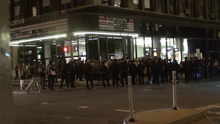2015 Baltimore protests
On April 12, 2015, Baltimore Police Department officers arrested Freddie Gray, a 25-year-old African American resident of Baltimore, Maryland. Gray's neck and spine were injured while he was in a police vehicle and he went into a coma. On April 18, there were protests in front of the Western district police station.[1][2] Gray died on April 19.
Further protests were organized after Gray's death became public knowledge, amid the police department's continuing inability to adequately or consistently explain the events following the arrest and the injuries. Spontaneous protests started after the funeral service, although several included violent elements. Civil unrest continued with at least twenty police officers injured, at least 250 people arrested, 285 to 350 businesses damaged, 150 vehicle fires, 60 structure fires,[13] 27 drugstores looted,[14] thousands of police and Maryland National Guard troops deployed, and with a state of emergency declared in the city limits of Baltimore.[15][16] The state of emergency was lifted on May 6.[17] The series of protests took place against a historical backdrop of racial and poverty issues in Baltimore.[18][19]
On May 1, 2015, Gray's death was ruled by the medical examiner to be a homicide. Six officers were charged with various offenses, including second-degree murder, in connection with Gray's death.[20] Three officers were subsequently acquitted; in July 2016, following the acquittals, Baltimore City State's Attorney Marilyn Mosby dropped charges against the remaining three officers.[21]
On April 12, 2015, Freddie Carlos Gray, Jr., a 25-year-old African-American man, was arrested by the Baltimore City Police Department for possession of a “switchblade”, in the 1700 block of Presbury Street in the Sandtown-Winchester neighborhood.[22][23] Two weeks later, State’s Attorney Marilyn Mosby revealed that Gray had actually been carrying a legal pocketknife, not an illegal switchblade as alleged by police.[24] Gray was seen to be in good health at the time of the arrest.
While being transported in a police van, Gray sustained injuries to his neck, including his vocal box and spinal cord. He fell into a coma and was taken to a trauma center. The BCPD could not immediately account for the injuries and released contradictory and inconsistent information regarding the timeline of the arrest, transportation and whether Gray had received appropriately prompt medical treatment.[1][2] On May 23, 2016, officer Edward Nero was found not guilty of all charges against him in connection with the death of Freddie Gray.[25] Shortly after that, the remaining officers who had not yet stood trial had all charges against them dropped.[21]
On April 18, 2015, immediately outside the Western District police station, hundreds of Baltimore citizens protested against the apparent mistreatment of Freddie Gray as well against inadequate and inconsistent information on police actions during the arrest and transport. Gray died at approximately 7am on April 19, 2015.[23] Later that day, in response to Gray's death, Baltimore City Police Commissioner, Anthony Batts said, "I extend my deepest sympathies to his family" while also saying, "All Lives Matter" in a nod to the "Black Lives Matter" mantra shouted at protests.[26]
.jpg/440px-Maryland_National_Guard_(17285160576).jpg)


.jpg/440px-Maryland_National_Guard_(17145635149).jpg)